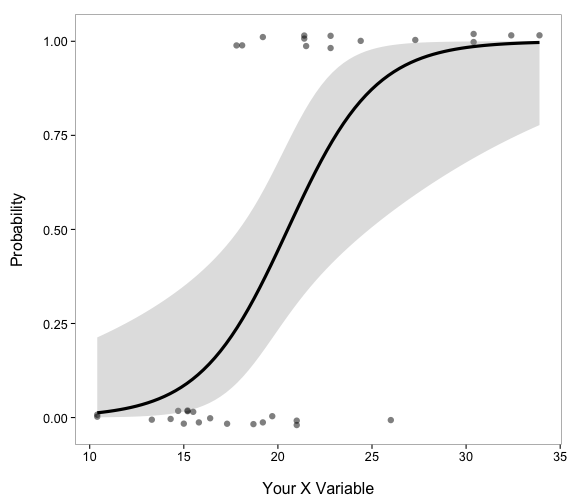Someone asked about plotting something like this today
I wrote a few functions previously to do something like this. However, since then ggplot2 has changed, and one of the functions no longer works.
Hence, I fixed opts() to theme(), theme_blank() to element_blank(), and panel.background = element_blank() to plot.background = element_blank() to get the histograms to show up with the line plot and not cover it.
The new functions:
loghistplot <- function(data) {
names(data) <- c('x','y') # rename columns
# get min and max axis values
min_x <- min(data$x)
max_x <- max(data$x)
min_y <- min(data$y)
max_y <- max(data$y)
# get bin numbers
bin_no <- max(hist(data$x, plot = FALSE)$counts) + 5
# create plots
a <- ggplot(data, aes(x = x, y = y)) +
theme_bw(base_size=16) +
geom_smooth(method = "glm", family = "binomial", se = TRUE,
colour='black', size=1.5, alpha = 0.3) +
scale_x_continuous(limits=c(min_x,max_x)) +
theme(panel.grid.major = element_blank(),
panel.grid.minor=element_blank(),
panel.background = element_blank(),
plot.background = element_blank()) +
labs(y = "Probability\n", x = "\nYour X Variable")
theme_loghist <- list(
theme(panel.grid.major = element_blank(),
panel.grid.minor=element_blank(),
axis.text.y = element_blank(),
axis.text.x = element_blank(),
axis.ticks = element_blank(),
panel.border = element_blank(),
panel.background = element_blank(),
plot.background = element_blank())
)
b <-
ggplot(data[data$y == unique(data$y)[1], ], aes(x = x)) +
theme_bw(base_size=16) +
geom_histogram(fill = "grey") +
scale_y_continuous(limits=c(0,bin_no)) +
scale_x_continuous(limits=c(min_x,max_x)) +
theme_loghist +
labs(y='\n', x='\n')
c <- ggplot(data[data$y == unique(data$y)[2], ], aes(x = x)) +
theme_bw(base_size=16) +
geom_histogram(fill = "grey") +
scale_y_continuous(trans='reverse', limits=c(bin_no,0)) +
scale_x_continuous(limits=c(min_x,max_x)) +
theme_loghist +
labs(y='\n', x='\n')
grid.newpage()
pushViewport(viewport(layout = grid.layout(1,1)))
vpa_ <- viewport(width = 1, height = 1, x = 0.5, y = 0.5)
vpb_ <- viewport(width = 1, height = 1, x = 0.5, y = 0.5)
vpc_ <- viewport(width = 1, height = 1, x = 0.5, y = 0.5)
print(b, vp = vpb_)
print(c, vp = vpc_)
print(a, vp = vpa_)
}
logpointplot <- function(data) {
names(data) <- c('x','y') # rename columns
# get min and max axis values
min_x <- min(data$x)
max_x <- max(data$x)
min_y <- min(data$y)
max_y <- max(data$y)
# create plots
ggplot(data, aes(x = x, y = y)) +
theme_bw(base_size=16) +
geom_point(size = 3, alpha = 0.5, position = position_jitter(w=0, h=0.02)) +
geom_smooth(method = "glm", family = "binomial", se = TRUE,
colour='black', size=1.5, alpha = 0.3) +
scale_x_continuous(limits=c(min_x,max_x)) +
theme(panel.grid.major = element_blank(),
panel.grid.minor=element_blank(),
panel.background = element_blank()) +
labs(y = "Probability\n", x = "\nYour X Variable")
}
Install ggplot2 and gridExtra if you don’t have them:
install.packages(c("ggplot2","gridExtra"), repos = "http://cran.rstudio.com")
And their use:
Logistic histogram plots
loghistplot(data=mtcars[,c("mpg","vs")])

loghistplot(movies[,c("rating","Action")])

Logistic point plots
loghistplot(data=mtcars[,c("mpg","vs")])

loghistplot(movies[,c("rating","Action")])
